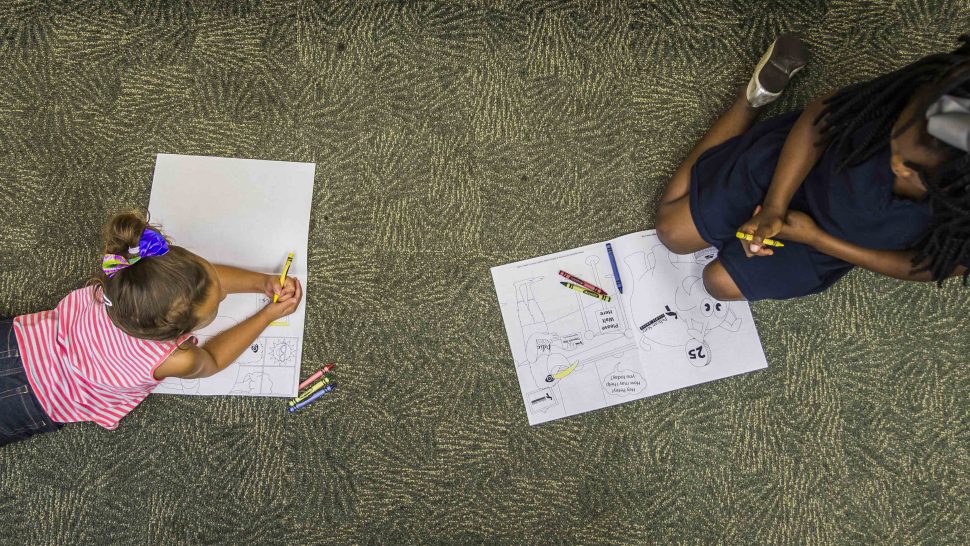Not having any kids of my own or family in the area to worry about, I clung to my phone during the flood, watching and waiting to make sure my co-workers and their families were safe. While my friends in northern Louisiana posted their kids’ back to school pictures, I hoped that all the children I saw staying afloat in boats, storage tubs and pool floats were going to bounce back with the same child-like resiliency they exhibit on the playground.
When I was able to get back to work, we had a good amount of kids that had no choice but to come to work with their parents. Most were smiling, and some were extremely quiet, doing their best to not disturb anyone. I wanted to ask them questions and check on them so badly, but I was worried I may say the wrong thing. I decided I would do a little more research so I would be prepared in the future.
 While checking the credit union’s Facebook page, I came across a Pelican member, Brittany Hébert Landry, who was doing her part to reach out to flood affected children. Brittany has been a member of our financial family for almost 8 years, and she is a Provisionally Licensed Professional Counselor with the LPC Board of Examiners and a Certified School Counselor registered with the Louisiana Board of Education.
While checking the credit union’s Facebook page, I came across a Pelican member, Brittany Hébert Landry, who was doing her part to reach out to flood affected children. Brittany has been a member of our financial family for almost 8 years, and she is a Provisionally Licensed Professional Counselor with the LPC Board of Examiners and a Certified School Counselor registered with the Louisiana Board of Education.
Brittany currently works in the Central Community School System, and with Central schools being closed until after Labor Day, she rolled up her sleeves and got to work doing whatever she could to help. On top of helping demo her friend and sister’s house, baking treats for her co-workers and friends and checking on all of her friends and family members in the area, Brittany also used her expertise to volunteer at the shelter in Celtic Studios on Airline Highway in Baton Rouge.
We wanted to know more about her experience at the shelter and get some advice on helping children cope with post-disaster depression. Here’s what she had to say:
What did your volunteer duties at Celtic Studios entail?
As a licensed counselor, my primary focus was working with child evacuees. At the shelter, I addressed any mental health concerns to appropriate staff (medical, volunteers, military, etc.). I provided emotional support as needed to both adult and children and consulted with licensed personnel on site on situations or issues outside my scope of practice. I linked evacuees with needed or requested information or resources. I helped shelter staff and volunteers as needed with other requests.
What was the mood of the children? How were they coping?
The majority of the children I encountered appeared to have had positive moods. These children were amicable and friendly and made friends with others at the shelter. However, there were a few that were quiet and appeared withdrawn. It is not to say the majority of the children were not affected by this tragedy but at least appeared to be coping in mostly appropriate ways. We encouraged the children to play and draw and socialize within the shelter. This was to help relieve some of their energies and stresses along with helping the parents to cope as well. A few children spoke with me about how things were “different” now either from not having a home to go home to or a school to attend at the time.

What different reactions do different age groups have to the disaster, and what different communication approaches are needed for each of these age groups?
0-5 Years Old: Children at this age have less developed verbal and emotional skills to deal with traumatic incidents. This is not to say that they may not understand what is going on, but it may be difficult for them to verbalize/express it to others. Children at this age may have difficulty going to sleep or experience some separation anxiety with caregivers. They may show some regressive behaviors such as baby talk or a change in toileting skills. They may experience night terrors or fear going to sleep.
It is helpful for the caregiver to provide comfort and rest to the child following the incident. Providing the child opportunity to play and draw is helpful in allowing the child to process the event. This age may need more reassurance that the event is over, and that the child and their family are safe now. Though the child may not be able to express their thoughts and feelings as well as an adult, it is helpful to provide them with useful vocabulary to help them better express their discomforts and worries. The child needs as much structure and routine as can be provided following the incident. Parents, teachers and caregivers may need to be more tolerant in regressive behaviors displayed by the child for a period. However, boundaries should still be firm.
5-12 Years Old: Children on the younger side of this spectrum may still have difficulty in expressing or verbalizing their thoughts and feelings to others. They may be prone to anxiety and feelings of concern about loved ones. They may feel overwhelmed by feelings of sadness, guilt or fear about the incident. This age may also have difficulty falling asleep, fear of sleeping alone or experience nightmares. These children may have difficulty concentrating and focusing at school. This age may also experience psychosomatic symptoms, that is physical symptoms manifested with no obvious cause such as stomach aches or headaches. The child may also be more reckless or aggressive in their behavior.
This age needs encouragement to express their thoughts and feelings to people they feel comfortable with so that they are not held internally, so that the child can begin processing the incident. Reassure the child that these feelings are normal, and correct any expressions that may not be true. It is helpful that the parents and teachers communicate with one another, especially if the child is showing any changes in attention and focus in the classroom.
12+ Years Old: This age group has the skills to express their feelings and thoughts but may not do so out of fear of being considered “abnormal” by their peers about their anxiety, fear or vulnerability regarding the event. This may cause them to withdraw from family and friends. This age may engage in reckless or self-destructive behavior as a result of the incident. The way they think about the world may change, a shift in their world-view.
It is important to encourage this age group as well to express their thoughts and feelings about the incident to someone they trust. An adolescent may display “acting out” behaviors, so it is important for their caregivers to help them understand that this may be a method of them coping with the incident. It is important to recognize the different family members’ way of coping and validating their feelings that accompany it.
Do you have any tips for parents/educators/youth leaders who are interacting with children affected by the flooding?
Please be patient with the child you are encountering. The child may be displaying behaviors that are not of the “norm” for themselves. They may be quiet, sullen, aggressive, withdrawn, hyperactive, inattentive, babyish or just “acting out”. Despite the behavior, it is still important to have firm boundaries with the child along with setting up a routine to help establish structure for them. It is important to allow the child to play. Play is a natural way for children to process their thoughts and feelings since their verbal/expressive skills are still developing. However, if this behavior continues for an unusually long period of time after the incident, the caregiver may want to have the child see their primary care or pediatrician. They may also check in with their school counselor or social worker.
Children with autism may have a harder time expressing themselves. Do you have tips for parents/teachers/youth leaders who work with these children?
A child with autism may be more likely to experience traumatic issues than a child not on the spectrum because of their sensitivity to certain stimuli and changes in structure. It is advisable to reestablish as much of the child’s routine and structure as can be possible. Attempt to provide the child with a place or location that has limited stimulus to prevent sensory overloads or behavioral outbursts. If they have an item that provides them comfort, you might want to make sure the child has easy access to it to promote calming. The child can be encouraged to express themselves in their own ways about what they may be feeling or thinking.
What will you be doing in your workplace to help children cope?
Since I work in a school as a school counselor, I plan on addressing the traumatic incident on multiple fronts. I normally provide guidance lessons to my students weekly, so we will likely be focusing on emotional regulation and coping skills. I am looking to provide my staff with information on what behaviors that may encounter from their students. I am also looking to distribute information to parents on behaviors to be aware of, what they can do to help their child process and resources they may need (housing, uniforms, food, mental health, etc.).
After speaking with Brittany, it’s clear that children have different ways of coping and may not show their struggles in the same way. It’s important to be on the lookout for signs of problems and to address them in the ways she recommends above. By following her tips, you can help your children cope with depression or any other problems they may be having after a disaster.
Have any additional questions for Brittany or resources for children affected by the flood that you would like to share? Let us know in the comments below.



